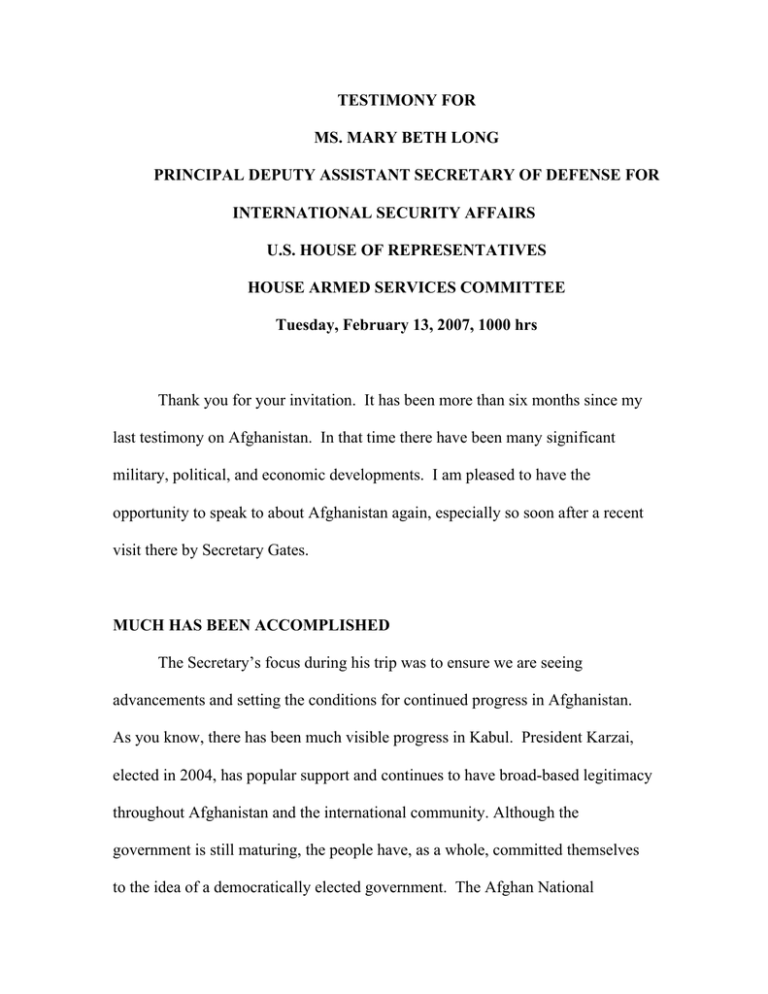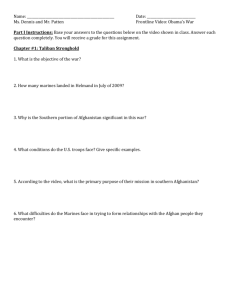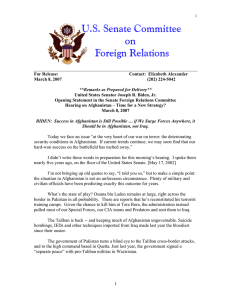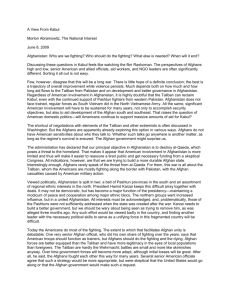TESTIMONY FOR MS. MARY BETH LONG INTERNATIONAL SECURITY AFFAIRS
advertisement

TESTIMONY FOR MS. MARY BETH LONG PRINCIPAL DEPUTY ASSISTANT SECRETARY OF DEFENSE FOR INTERNATIONAL SECURITY AFFAIRS U.S. HOUSE OF REPRESENTATIVES HOUSE ARMED SERVICES COMMITTEE Tuesday, February 13, 2007, 1000 hrs Thank you for your invitation. It has been more than six months since my last testimony on Afghanistan. In that time there have been many significant military, political, and economic developments. I am pleased to have the opportunity to speak to about Afghanistan again, especially so soon after a recent visit there by Secretary Gates. MUCH HAS BEEN ACCOMPLISHED The Secretary’s focus during his trip was to ensure we are seeing advancements and setting the conditions for continued progress in Afghanistan. As you know, there has been much visible progress in Kabul. President Karzai, elected in 2004, has popular support and continues to have broad-based legitimacy throughout Afghanistan and the international community. Although the government is still maturing, the people have, as a whole, committed themselves to the idea of a democratically elected government. The Afghan National Assembly has proved to be an impressive symbol of Afghan governance. Though many observers feared the Assembly would serve as a vehicle to legitimize bad actors, the group had an impressive first year: it has confirmed Cabinet and Supreme Court appointments, passed a national budget, and reviewed Presidential decrees. Equally impressive has been the increased commitment of our allies. To echo Secretary Gates’ comments, it is remarkable that over three dozen countries have determined that Afghanistan is important to their national interest. And it has been a largely successful commitment: on October 5th of last year, NATO’s International Security Assistance Force completed the expansion of its mission, three years after it took the decision to seek command over all of Afghanistan. ISAF, currently commanded by U.S. General Dan McNeill, is supporting stability, security, and reconstruction throughout the country with combat forces and 25 Provincial Reconstruction Teams. ISAF also executed the successful Operation Medusa which thwarted a significant Taliban attack on the city of Khandahar this past fall, demonstrating ISAF’s willingness to stand, fight and defeat a major Taliban attack. Though our allies are taking a larger role, we cannot forget that the backbone of our efforts in Afghanistan is a U.S.-Afghan partnership that is growing stronger, both strategically and operationally. We consider the partnership enduring. Next month, a USG delegation will travel to Kabul to 2 continue the important work begun in 2005 with the signing of the Joint Declaration of the United States-Afghanistan Strategic Partnership. During a visit last month to the Forward Operating Base Tillman, Secretary Gates met with U.S. and Afghan National Army forces; and saw first hand how they live together, how they work together, and how they fight together. In fact, the Afghan National Security Forces, soldiers and policemen, trained and equipped with Allied support are approximately 90,000. They are taking the lead at an increasing rate on operations to secure their country and form a foundation that other national institutions can emulate and build upon. MUCH REMAINS TO BE DONE Yet, with all of this progress, the new Afghanistan is still vulnerable. This past summer, the Taliban launched an aggressive campaign of violence against Afghan and international forces in the south and east. This spring, we expect the Taliban will attempt to leverage both real and propaganda gains from 2006, as well as operating from improved safe havens, to launch a stronger offensive. The Taliban do not need to win in traditional military fashion in Afghanistan to achieve success – they only need to undermine the Afghan people’s sense of security and confidence in their government. Much of our success in Afghanistan comes from the fact that we are operating in a generally benign and supportive operational environment. The vast 3 majority of Afghan citizens welcome our presence and our efforts. The Taliban seek to turn the population against us this spring. We will not let that happen. To support the new democratic government in Kabul, we have conducted a review of our overall policy and are adopting a complete approach that works to integrate military efforts with political support, counternarcotics programs, a development agenda and regional diplomacy. If there is to be an “offensive” this spring, it will be our offensive, and it will be comprehensive. However, in spite of the clear warning signs of increased Taliban activity, NATO forces need to do more to fully prepare. Many allies have provided forces for Afghanistan but have tethered them by restrictive national caveats which do not allow the NATO commander the flexibility to deploy forces as he sees fit. NATO still has shortfalls in meeting its force requirements and still needs effective mechanisms to coordinate and facilitate assistance to the government of Afghanistan. Secretary Gates, during last week’s Defense Ministerial in Seville, discussed these deficiencies and their impact on our efforts in Afghanistan in very candid terms. We will continue to work within NATO to remedy these shortcomings and will work with our partners to generate the political will necessary to make the difficult choices required for success. SHIFT IN THE STRATEGIC ENVIRONMENT 4 This past year’s increase in violence and narcotics production represents a shift in the strategic environment. Taliban presence and strength have grown in some areas of the country, especially in the South, and the relatively weak institutions of the GoA enable insurgents to operate in the absence of a government or coalition presence. As a result, the United States, in cooperation with our ISAF partners, must accelerate and increase our efforts in order to achieve the desired effects of extending governance, increasing prosperity and providing security in Afghanistan. In the security sector, the shift in the strategic environment highlighted the need to revise and strengthen the ANSF training and equipping program. The $5.9B requested in the FY07 GWOT Supplemental and the $2.7B requested in the FY08 GWOT budget request will enable the ANSF to respond to the resurgent Taliban by accelerating the pace of our ANSF train and equip program and expanding the size and capabilities of these forces. The ANSF needs to be a professional, capable, respected, multi-ethnic, and sustainable force. The ANSF we are building must be less reliant on international forces presence in the long term and more capable of independently bringing the fight to the Taliban. The ‘build’ phase of the accelerated programs for both the ANA and ANP will require significant upfront investment, primarily for infrastructure and equipment, which we are looking to fund primarily through the $5.9B FY07 Emergency Supplemental and complete with the $2.7B FY08 GWOT budget 5 request. Our focus in the out years will then shift to sustainment which we estimate at approximately $2B annually. Afghan National Army The program to train and equip the ANA builds on the current success. The Afghan Ministry of Defense, through effective recruiting and ethnic integration has created a national army that is representative of Afghans of all backgrounds. Additionally, the Ministry should be praised for its effective efforts to decrease its absentee rate, now reduced to an average of 12% from a high of 38%, as well as its largely successful program to ensure new recruits are properly vetted. ANA soldiers have fought bravely side-by-side with the international forces and won the respect of the Afghan people, despite less reliable weapons and weaker force protection. Building upon the strong foundation established at the Ministry level, the acceleration program will arm Afghan soldiers with reliable and more capable weapons including assault rifles, machine guns, and mortars. Soldiers will also receive body armor, Kevlar helmets, armored vehicles, and advanced first aid kits to ensure care for those who are injured. The full 70,000 person force of 14 brigades will include better capabilities such as a small, but capable air corps that will significantly increase the Army’s combat mobility and agility. Six battalions will receive specialized training to 6 become the rapid response Commando Battalions, focused on the counterinsurgency mission. In addition, the Army will now include combat support units, including engineering units, military intelligence companies, and military police. Afghan National Police The revised program recognizes that a more robust police force is required for the mission and also seeks to help the police catch up with the Army, which has received more U.S. attention and resources to date. The Departments of Defense and State plan to train and equip an expanded force of 82,000, which again will build upon important strides made in the last year at the Ministry level. The Ministry of Interior, with help from U.S. and international mentors, is in the final stages of completing reform of its pay and rank system. As of last week, thirty two of Afghanistan’s thirty four provinces will have instituted an electronic pay system which will have a critical impact on recruiting and retention for police. Additionally, the Ministry of Interior is making strides in culling bad actors from its senior ranks. This clear initiative on the part of the Afghans will again form the basis for our accelerated program which will now include enhanced specialized units to address some of Afghanistan’s key issues. One example of these units, the Counternarcotics Police (CNP-A) program, will be accelerated to develop a force modeled on the U.S. Drug Enforcement Agency. The CNP-A will target drug traffickers and producers, improving 7 Afghanistan’s interdiction capabilities. This year and next, we expect to complete helicopter deployments to support the CNP-A’s National Investigative Unit, improve overall investigative capacities, and expand the reach of the CNP-A to regions outside of Kabul. The Afghan Border Police (ABP) also will receive additional capabilities and equipment to improve its ability to perform its mission. This increased Afghan capacity to arrest major traffickers and remove corrupt officials linked to trafficking will be essential to helping the Afghans address the scourge of illicit narcotics that threatens the foundations of this young government. Additionally, a new unit will be established to fill a gap in ANP capability. The Civil Order Police (COP) with tactical gear, improved force protection, and specialized equipment, will be the rapid specialized response force for civil emergencies like the May 2006 Kabul riots. It is important to note, the international community also has a role in building the ANSF. The U.S. cannot achieve or sustain these ANSF objectives alone. Millions of dollars of equipment have been donated by countries for both the ANA and ANP, but it falls far short of what is needed and what has been pledged. Germany has played a key part with its police training program, and ISAF countries contribute Operational Mentor and Liaison Teams (OMLTs) that embed with trained ANA units to provide in-the-field mentoring. These teams are critical, and we are working with NATO to fulfill its pledge of 69 teams as it 8 explores near and long-term ways it can do more to assist with training and equipping. We recognize that security alone will not win in Afghanistan. To complete the transition from terrorist safe haven to a moderate, independent state, Afghanistan will need infrastructure, economic development, and improved governance and services. To that end, the Commander’s Emergency Relief Program (CERP) funds are a key element of our military strategy in Afghanistan. CERP provides the commander with the funds required to bring needed assistance and reconstruction to areas that have been affected by conflict. Unlike other U.S. or other international community resources, CERP provides a quick impact and demonstrates immediate benefits to the people of Afghanistan. Aside from addressing the threat to Afghanistan by building internal security capacity and facilitating reconstruction, we are working to address regional actors as well, notably in Pakistan. Both Afghanistan and Pakistan must cooperate against extremists in both countries to end the insurgency in Afghanistan and to reverse increased extremist influence in Pakistan. Despite some indications of greater cooperation, cross-border insurgency remains a problem. We are working to build on the Presidents’ tri-lateral dinner agreements from September by encouraging the planning and coordination of the agreed Joint Jirgas to address the border areas and by supporting Pakistan’s Frontier Strategy for the Federally Administered Tribal Areas (FATA). We are increasing our 9 engagement with Pakistan and encouraging the international community, especially NATO and individual contributors to ISAF, to do the same. WAY AHEAD But these challenges are manageable. We are making steady headway in Afghanistan. We can secure our gains and continue to make progress. In the near-term, this requires us not only to respond to the Taliban offensive, but also to enforce a decisive setback to the Taliban. Such gains in the security sector will enable progress towards a moderate, stable Afghanistan which is so essential to our strategic security. Consequently, we must continue to make progress in all sectors. For the Afghan National Security Forces, this will mean an increase in size and capabilities of the forces. To lead, the ANSF must be trained and equipped to face their enemy. This development must also be accelerated to ensure that the Afghans have the right capabilities in place to respond to an adaptive enemy. While the Afghans have the will, they need the continued commitment, expertise, and assistance of the international community to succeed. It is imperative now for the United States and the international community to deliver on those pledges and ensure the people of Afghanistan see an improved and secure quality of life now and for future generations. Continued success depends upon timely Congressional support for this supplemental request, and I look forward to your questions. 10








